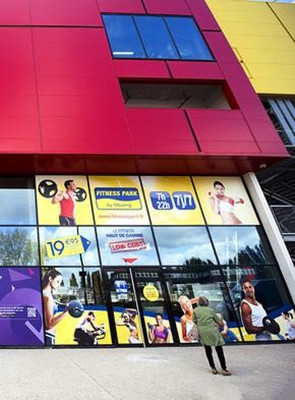法國消費者
Made in France, not
法國制造,真的嗎?
What a new love of shopping malls says about French society
購物中心的新寵如何評價法國社會
WITH polished stone floors and a plate-glass roof, a shimmering multi-storey shopping mall has just opened beside a motorway north of Paris. Named Qwartz, and costing 300m ($510m), it houses 165 shops and what developers call “eating concepts”. Two other American-style shopping malls opened in the greater Paris region last year, and a third, So Ouest, in 2012. A country that prides itself on chic designer boutiques and artisanal shops seems to be turning into one of mall rats.
一個帶有拋光的石質地板和平面屋頂、閃閃發亮的多層購物中心剛剛在巴黎北邊的高速公路旁開業。這個名叫Qwartz的購物中心,斥資30億歐元(約合51億美元),擁有165家商鋪,并且正在發展“飲食理念”。另外兩家美式風格的購物中心去年在大巴黎地區開業,第三家名為So Ouest的購物中心于2012年開業。一個以時尚設計精品店和手工店為傲的國家如今似乎正向繁多的購物街轉變。

Partly this is just catching up. Until recently, strict planning rules stopped big out-of-town shopping centres around the French capital. Most malls that existed, such as Vélizy 2 or Rosny 2, dated from the 1970s, when five new towns were built in the Paris suburbs. But a new relaxed attitude has now let more modern projects go ahead.
這種現象的一部分原因是趕時髦。截至最近,法國首都嚴格的計劃規則將大型外來購物中心拒之門外。大多數像Vélizy 2 或 Rosny 2那樣的購物街是從上世紀70年代就在巴黎存在了,那時正值巴黎城郊新建了五個小鎮。但是一個新的隨意態度讓更多現代項目得以進行。
It also points to two features of French society that escape the gaze of historic Paris. One is most shoppers' suburban way of life. Only 2.2m people live in the capital itself. Yet the greater Paris region, excluding the city, counts over four times more inhabitants, many in small towns and car-dependent suburbs. The new malls, ringed by car parks, are handy, even alluring. Fully 62% of the French told one poll that malls were their favourite places to shop, ahead of the high street or traditional department stores.
這也表明了法國社會常被歷史悠久的巴黎忽視的兩個特點。一個是大多數購物者的郊區生活方式。只有220萬人住在首都里。但是大巴黎地區,不包括城區,居民超過首都四倍,其中很多人住在小城鎮和以汽車代步的郊區。新型購物中心被停車位環繞,非常方便,甚至非常有吸引力。足足有62%的法國人在一項民意調查中透露相比正統商業街和傳統百貨商店,購物中心是他們購物的最愛。
The other trend is the global taste of consumers. Besides a huge French hypermarket, Qwartz's big pull is Primark, an Irish cheap-fashion retailer, and Marks & Spencer, a British chain. Just down the road, So Ouest boasts Hollister, an American surfwear brand, Starbucks, an American coffee house, and ubiquitous foreign fashion chains such as H&M (Swedish) and Zara (Spanish). In today's temples of consumption, global is a la mode.
另一個流行趨勢是全球顧客的品味。除了一個大型法國大規模超級市場,Qwartz主要是由愛爾蘭的廉價流行零售店Primark和英國連鎖Marks & Spencer來支撐。在So Ouest 購物中心的盡頭,充斥著美國沖浪服品牌Hollister和美國咖啡屋Starbucks,還有無處不在的外國流行連鎖店如H&M(瑞典),還有Zara(西班牙)。在如今消費圣殿里,全球化正大行其道。
This is not quite the France favoured by Arnaud Montebourg, the industry minister and architect of a “Made in France” campaign. He is now trying to keep American hands off Alstom, the French maker of TGV fast trains. He once posed cheerfully for a magazine, dressed in a striped Breton top and holding a Moulinex food-blender.
這種潮流并未讓推崇法國的工業部長阿諾·蒙特布格退卻,他還要策劃“法國制造”運動。現在他正努力阻止美國插手TGV高速貨車制造商Alstom。他還曾身著布列塔尼上衣、手舉萬能牌食物攪拌器容光煥發地登上一本雜志。
Yet even French brands are not always home-made, as Benjamin Carle, a reporter, discovered filming a television documentary about his efforts to live for a year using only products made in France. The result was comic—and sobering. Not only was it impossible to find some items, including a fridge and coffee. Mr Carle initially had to empty his flat of anything that did not meet the test of 50% of its value being made in France. Out went the bicycle, computer, guitar, most of the furniture, beer, clothes, toothbrush and more. The share of his stuff that qualified as French-made? Just 4.5%.
但正如記者本杰明·卡爾拍攝的電視紀錄探索片講述的一樣,即使是法國品牌也不一定是法國制造。這部片子是記錄他只用法國制造的商品生活的一年。結果很有趣也很嚴峻。不僅僅是因為法國沒有制造像冰箱和咖啡這樣的商品。卡爾最初還必須清空他的公寓,因為沒有東西符合“法國制造”的測試要求,即價值的至少一半要是法國制造。除了自行車、電腦。吉他,大多家具、啤酒、衣物、牙刷等等都不是法國制造。他的東西有多少符合法國制造的定義呢?只有4.5%。譯者:邵夏沁 校對:張丹












